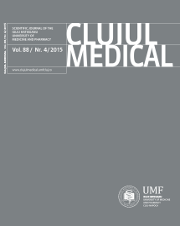Spectrophotometric color evaluation of permanent incisors, canines and molars. A cross-sectional clinical study
DOI:
https://doi.org/10.15386/cjmed-497Keywords:
color, spectrophotometer, color difference, permanent natural teethAbstract
Background and aims. An accurate color reproduction represents the final validation level of an esthetic anterior or posterior restoration. The aim of this study was to evaluate the color of permanent maxillary incisors, canines and molars, using a clinical spectrophotometer.
Methods. The Vita Easyshade Advance 4.0® intraoral spectrophotometer was used by one clinician to determine the color of 369 permanent maxillary incisors, canines and molars. The best matches to Vitapan Classical® and 3D-Master® shade guides were recorded. A one-way analysis of variance and Kruskal-Wallis test were used to compare L*, a*, b*, c* and h* color coordinates among the 3 types of teeth. Differences between the mean values of all color coordinates were evaluated by use of Bonferroni corrections. Color difference (ΔE*) between incisors, canines and molars was calculated from ΔL*, Δa* and Δb* data and the results were compared to ΔE*=3.3 acceptability threshold.
Results. Except for Δa* and Δh* between canines and molars, statistically significant differences among the mean differences of all color coordinates were found when the 3 types of teeth were compared by pairs. The most frequently measured shades were A1 (48.4%), respectively 1M1 (31.5%) for incisors, B3 (36.6%), respectively 2M3 (39.8%) for canines and B3 (44.7%), respectively 2M3 (52%) for molars. Incisors had the highest lightness values, followed by canines and molars. Molars were the most chromatic with the highest a* and b* values.
Conclusions. Despite the limitations of this study, color differences among incisors, canines and molars were found to be statistically significant, above the clinical acceptability threshold established. In conclusion, successful esthetic restorations of permanent teeth of the same patient need an individual color assessment and reproduction of every type of tooth.
Downloads
Additional Files
Published
How to Cite
Issue
Section
License
The authors are required to transfer the copyright of the published paper to the journal. This is done by agreeing to sign the Copyright Assignment Form. Whenever the case, authors are also required to send permissions to reproduce material (such as illustrations) from the copyright holder.

The papers published in the journal are licensed under a Creative Commons Attribution-NonCommercial-NoDerivatives 4.0 International License.

